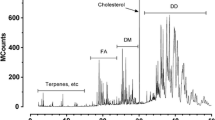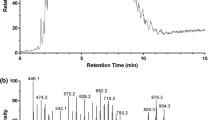Abstract
Cholesteryl esters were found to constitute a major component of the lipids coating the body cuticle of females of the camel tick, Hyalomma dromedarii and the brown dog tick, Rhipicephalus sanguineus. One or more cholesteryl esters, alone or in combination, have been shown to serve as the mounting sex pheromone of several species of ixodid ticks. Consequently, knowledge of these compounds is important for an understanding of the mating behavior of these ticks. Based on thin layer chromatography, cholesterol and cholesteryl esters were the most abundant neutral lipids found on the body surfaces of fed females of these two species. Analysis using HPLC demonstrated significant quantities of the following compounds, tentatively identified as cholesteryl esters (expressed in micrograms per female equivalent), in H. dromedarii: Cholesteryl acetate 18.2; cholesteryl laurate, 6.8; cholesteryl linoleate, 24.8; cholesteryl oleate, 12.9; cholesteryl palmitate, 0.3; and cholesteryl stearate 1.7.
In contrast, the same method revealed only 3 cholesteryl esters in extracts of females of R. sanguineus: Cholesteryl acetate, 2.0; cholesteryl linoleate, 8.5; and cholesteryl oleate, 3.0. In both species, two unidentified peaks, with the spectral characteristics of cholesteryl esters, were also observed. Identification of the cholesteryl esters was confirmed: by (1) positive bioassay results with conspecific (H. dromedarii) males and heterospecific (Dermacentor variabilis) males; (2) similarity of ultraviolet spectra between identified sample peaks and authentic standards; and (3) demonstration of cholesterol and the corresponding free fatty acid following enzymatic digestion of each of the HPLC-separated fractions containing the different cholesteryl esters. Comparisons with the cholesteryl ester composition of the mounting sex pheromone of other metastriate Ixodidae are discussed. These findings, along with studies reported previously, suggest that differences in the mounting sex pheromones of ixodid ticks are an important factor in minimizing heterospecific matings in nature.
Similar content being viewed by others
References
Allan, S.A., Phillips, J.S. and Sonenshine, D.E. 1991 Amblyomma americanum and Amblyomma maculatum (Acari: Ixodidae). Role of genital sex pheromones. Exp. Appl. Acarol. 11: 9–21.
Hamilton, J.G.C. and D.E. Sonenshine. 1988. Evidence for the occurrence of mounting sex pheromone on body surface of female Dermacentor variabilis (Say) (Acari: Ixodidae). J. Chem. Ecol. 14: 401–410.
Hamilton, J.G.C., Sonenshine, D.E. and Lusby, W.R. 1989. Cholesteryl oleate; mounting sex pheromone of the hard tick, Dermacentor variabilis (Say) (Acari: Ixodidae). J. Insect Physiol. 35: 873–879.
Hoogstraal, H. 1967. Ticks in relation to human diseases caused by Rickettsia species. Annu. Rev. Entomol. 12: 377–420.
Hoogstraal, H. 1973. Viruses and ticks. Chapter 18. pp. 349–390. In: Gibbs, A.J. (Ed.) Viruses and Invertebrates. Elsvier-North Holland Publ. Co., New York.
Norval, R.A.I., Perry, B.D. and Young, A.S., 1992b. The epidemiology of theileriosis in Africa. Academic Press, Inc., London, 481 pp.
Phillips, J.S. and Sonenshine, D.E. 1993. Role of the male claw sensilla in perception of female mounting sex pheromone in Dermacentor variabilis, Dermacentor andersoni and Amblyomma americanum. Exp. Appl. Acarol. 17: 631–653.
Sonenshine, D.E. 1985. Pheromones and other semiochemicals of the Acari. Ann. Rev. Entomol. 30: 1–28.
Sonenshine, D.E. 1991. Biology of Ticks. Volume 1, Oxford University Press. New York, 447 pp.
Sonenshine, D.E., Homsher, P.J., Carson, K.A. and Wang, V.B. 1984. Evidence of the role of the cheliceral digits in the perception of genital sex pheromones during mating in the American dog tick, Dermacentor variabilis (Say) (Acari: Ixodidae). J. Med. Entomol. 21: 296–306.
Sonenshine, D.E., Hamilton, J.G., Phillips, J.S. and Lusby, W.R. 1991. Mounting sex pheromone: its role in regulation of mate recognition in the Ixodidae. Vol. 1, pp. 71–78. In: Dusbabek, F. and Bukva, V. (eds.) Modern Acarology, Prague & SPB Academic, the Hague.
van Straten, M. and Jongejan, F. 1993. Ticks (Acari: Ixodidae) infesting the Arabian camel (Camelus dromedarius) in the Sinai, Egypt with a note on the acaricidal efficacy of Ivermectin. Exp. Appl. Acarol. 17: 605–616.
Author information
Authors and Affiliations
Additional information
Supported by Cooperative Agreement No. 263-0152-A-00-2207 with the U. S. Agency for International Development to the Department of Infectious Diseases. College of Veterinary Medicine, University of Florida, Gainesville, FL and a subcontract, ODURF No. 536521, to the Department of Biological Sciences, Old Dominion University, Norfolk, VA
Rights and permissions
About this article
Cite this article
Sobbhy, H., Aggour, M.G., Sonenshine, D.E. et al. Cholesteryl esters on the body surfaces of the camel tick, Hyalomma dromedarii (Koch, 1844) and the brown dog tick, Rhipicephalus sanguineus (Latreille, 1806). Exp Appl Acarol 18, 265–280 (1994). https://doi.org/10.1007/BF00132316
Issue Date:
DOI: https://doi.org/10.1007/BF00132316




